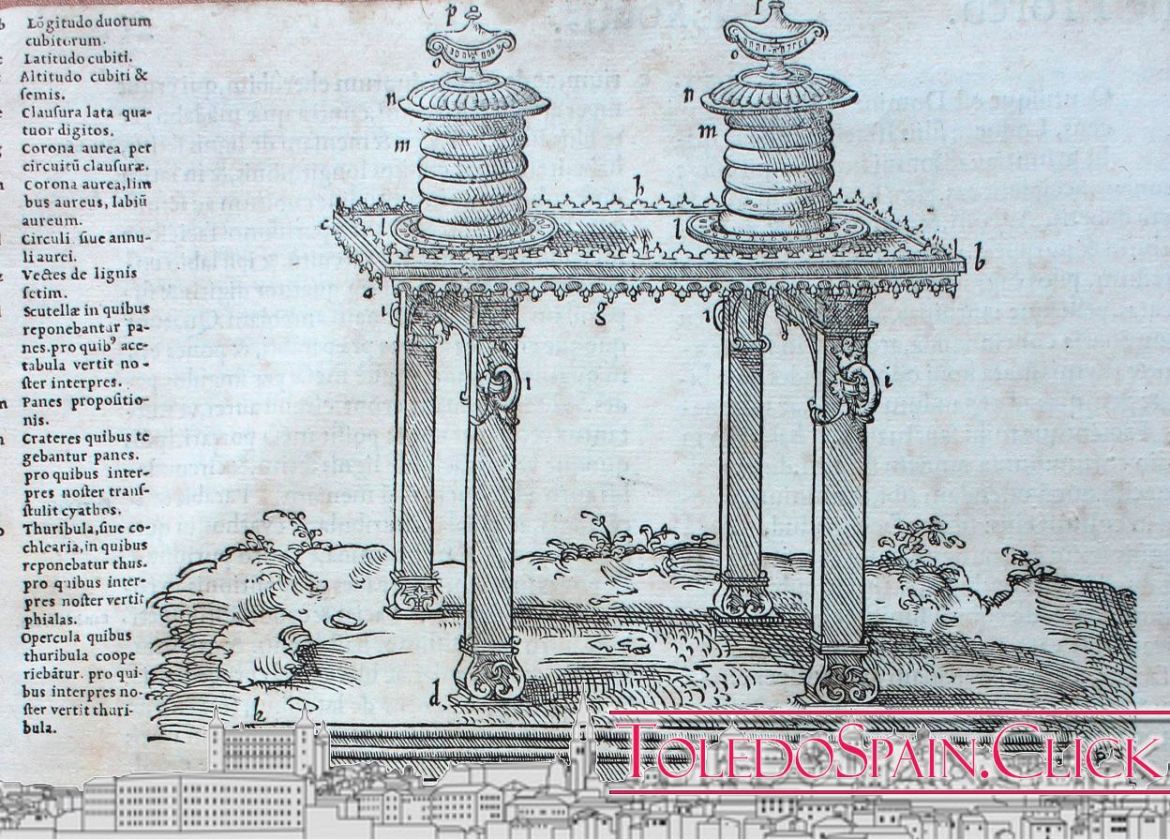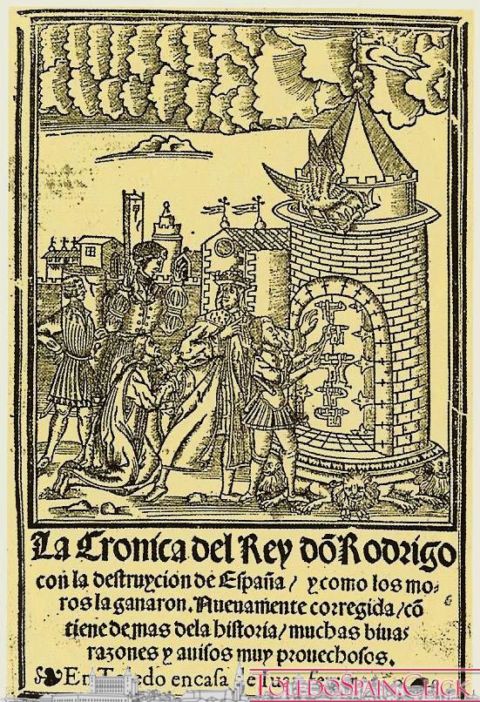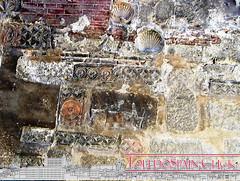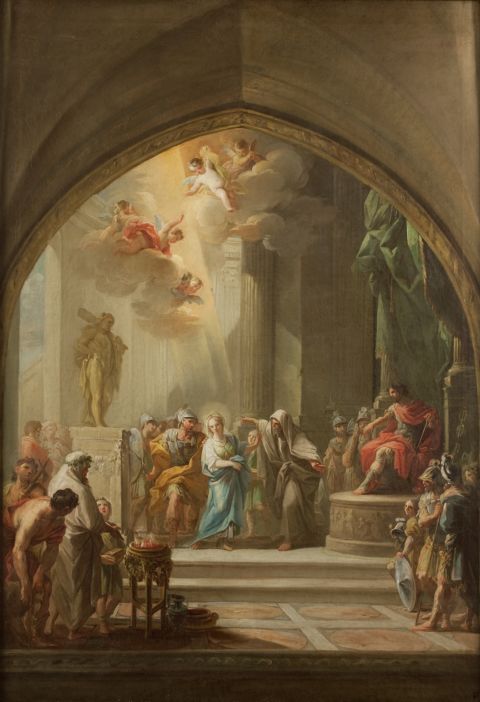This is a unique object for its symbolic and material value that the Arabs found in the capital of the Visigothic Kingdom in the early days of the conquest and the Muslim chronicles unanimously called “Table of Solomon”.
Over the last few months, a good stir has been forming around the subterranean areas of the famous “Cueva de Hércules” (Hercules Cave) that Toledo hides. It has also always been known that these subways could contain fabulous treasures that numerous “researchers” have been desperately trying to find for centuries. Among them, the “Table of Solomon“.
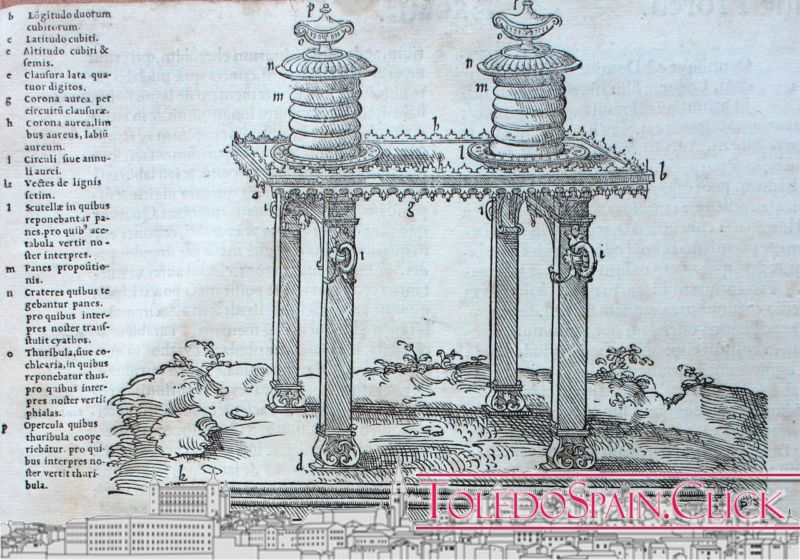 Cave of Hercules in Toledo by Toledospain
Cave of Hercules in Toledo by Toledospain
This is a unique object for its symbolic and material value that the Arabs found in the capital of the Visigothic kingdom in the early days of the conquest and the Muslim chronicles unanimously named Table of Solomon. This episode was widely publicized and was mentioned along with the story of “The Closed House of Toledo” in The Thousand and One Nights.
Documentation on Solomon’s table compiled by Ángel Almazán de Gracia and other authors:
THE ARAB AND BEREBER CRONICS
1º) Ajbar Machmua picks up an anonymous chronicle from the 11th century, in which it is read:
” Tárik arrived in Toledo, and leaving some troops there, continued his march to Guadalajara, then went to the mountain, passing through the gorge that took his name, and came to a city on the other side of the mountain, called Almeida (the Table), name due to the circumstance of having found in it the Table of Solomon, son of David, whose edges and feet, 365 in number, were emerald green. Then he came to the city of Amaya, where he found jewels and riches, and… he returned to Toledo in the year 93.
2º) The pseudo Ben Qutaiba in Imamat wa-l-Siasat:
” Then Muse marched through the country, until he came to the city of kings, Toledo, where he found a palace called the “mansion of the monarchs,” so called because of the fact that there were found twenty-four diadems of gold, one for each of the kings who had reigned in Spain. Each diadem had an inscription saying the name of the king to whom it had belonged, the number of children it had left, the day of its birth, the day of its ascent to the throne and the day of its death; for it was the custom among the Goths sovereigns of Spain that the diadem worn by each of them during their lifetime should, after their death, be deposited in that mansion. In addition to these treasures Musa found in the same palace a table in which was the name of Solomon, son of David (above both be peace) and another table of agate. When Muse saw these objects, he immediately placed them in the custody of persons of trust, chosen by him, and hid them from his own eyes, for such was the value of these and other precious objects found at the time of the invasion of Spain by the Muslims, that there was not a single man in the army who could (or even approximately) appreciate their value; thus with respect to silver, gold, brocades and other articles of clothing or furniture, no man, however skillful, could calculate them.
3) Ben Abu Al-Hakam in Kitab Futuh Misr writes:
” Abd al-Rahman, with reference to Yahya ben Buqair, and this one supported by Al-Laith ben Saad, tells that when Spain was conquered by Musa ben Nusayr, he took the table of Solomon, son of David, and the crown. They told Tariq that the table was in a castle called Farás, two days from Toledo, and that its governor was a son of Rodrigo’s sister. Tariq offered him a security letter for himself and his family, and having accepted, he presented himself and was picked up by Tariq, as he had promised. Tariq promised him the table and handed it over. He had so much gold and jewelry that nothing like it had ever been seen before. Tariq ripped off one of his feet with the gold and pearls that he had, and ordered him to put another one like it, valued at 200,000 dinars…”.
4th ) Al-Maqqari in Naft al-tib:
” Ben Hayyan [in his History of the Mohammedan Dynasties] tells us that that famous table that is said to come from Solomon, according to the Christians, did not belong to him, and that its origin is that in the times of the Christian kings there was the custom that when a rich lord died he left a command to the churches, and with these goods they made great utensils of tables and thrones, and other such things of gold and silver, in which their priests and clergymen carried the books of the Gospels, when they were taught in their ceremonies, and which they placed on the altars on feast days, to give them greater splendor with this apparatus (or adornment).

From the Old Collection of the Library of the University of Seville from Seville, Spain – “Candelabrum Aureum Tabernaculi”, Public Domain, Link
This table was in Toledo for this reason, and the kings strove to enrich it porfia, each adding something to what his predecessor had done, until it exceeded all other jewelry of this genre, and became very famous. It was made of pure gold, inlaid with pearls, rubies and emeralds, so lucky that no other had been seen like it. They tried so hard to enrich it, because since the capital of the kingdom was there, they did not want there to be any more beautiful jewels or more precious furniture than there. It was placed on an altar in the church of Toledo, where the muslims found it, and its discovery was made public and notorious at that moment. Tariq already suspected what happened after the envy of Musa, for the advantages he had achieved, and that he had to order the delivery of everything he had, so he thought to tear off one of his feet and hide it in his house, and this was, as is known, one of the reasons that Tariq was the winner of Musa in the dispute that later had before the caliph over their respective conquests.
By studying the preserved versions, it is discovered that there are two oral traditions that have been collected by the written sources, one that gathers the oriental tradition, and the other gathers the Andalusian tradition. They show the disagreement that exists in the Muslim tradition about the place where it was found, the materials with which it was built and even the function that this object had. The discrepancy is so evident that it leads us to think that the different sources refer to different objects that were found in the early times of the conquest and that ended up receiving the same name. The oldest versions that are preserved are those of Ibn Habib and those of Abd al-Hakam, who collect the chain of transmission of this news. Except for one of the authorities mentioned by Ibn Habib, the rest of the characters on which these stories are based lead to al-Layt b. Sá d. (d. 175/791), an Egyptian who achieved a great reputation as a jurist in al-Andalus. These sources are precise as to the description of the piece of furniture and coincide with the Andalusian chronicles in the contradiction of attributing the discovery of the Table to both Muza and Tarik.
The most complete is that of Abd al-Hakam, who collects the news of Utman Ibn Salih (d. 834?):
” Utman and other historians say… Tarik went to Toledo, entered the city and asked for the Table, because he was not worried about anything else, since it was the Table of Solomon, son of David, according to the people of the Book. And Yahya ibn Bukayr says, according to the testimony of al-Layt ibn Sa’d: He was invaded al-Andalus by Musa ibn Nusayr and took Solomon’s Table and the crown.
They say about Tariq that the Table was in a fortress called “Firas”, at a distance of two days from Toledo, and in charge of it was a nephew of Rodrigo who asked the aman for him and for his to Tariq. He came to him and granted it to him, being faithful to it. And he said to him: “Give me the Table” and gave it to him. The Table had a quantity of gold and precious stones such as had never been seen before. Tariq ripped off one of his legs with its precious stones and gold, placing another one in its place. It is estimated that the value of the Table was of two hundred thousand for what it had of gold and precious stones”. According to Abd al’-Hakam, whose account is later, Tariq was forced to hand over the Table and the booty achieved in the conquest to Muse b. Nusayr, but used the leg as proof that it had been he who got it: “It is said that Muse b. Nusayr came to the Caliph al-Walid ibn Abd al Maliq, when he was ill, and gave him the Table; Tariq said then:
” I was the one who got it,” but Musa denied it. Tariq said to al-Walid:
” Bring the Table and look at it: Is there anything missing?. The Caliph brought it, looked at it, and saw that one of its legs was different from the others. Tariq then said, “Ask him, O Prince of believers, and if what he tells you convinces you, he is right. Al-Walid asked Musa and he said: “Thus I have found her”. Then Tariq pulled out the leg he had torn out when he had seized it and said: “This is the proof, O Prince of believers! that I have told the truth and that it was I who got it. al-Walid believed him, accepting his word, and gave him a great reward. lbn Habib who gathers the testimony of al-Layt, says that the Table is found by Tariq; and leaves us a more detailed description of the Table of Solomon, from Abd al-Hamid ibn Humayd:” Abd Allah ibn Wahb ibn al-Layt tells us that Tariq, a client of Musa ibn Nusayr, when he conquered Toledo, took the Table of Solomon, son of David, which was crowned with precious stones, made of gold, adorned with aljophars and hyacinths, and whose price was incalculable. There was also another onyx table, also priceless. Said Abd al-Hamid: “I asked my father to describe to me the Table that he had seen and looked at, and he said to me: “It was of gold and silver mixed, with the yellow color of gold and the white of silver. Above her was a necklace of pearls, a necklace of hyacinths, and an emerald necklace. I asked him: “What was its size?” and he replied: “They carried it on a mule, the strongest one they could find, and it had not walked a day when its legs broke” “The Andalusian tradition does not focus on the development of the conquest or the description of the Table, but, on the contrary, on its remote origin and the reason why it was in al-Andalus. This news collected only by late Andalusian or Maghrebi writers seems to have its origin in the work of al-Razi, although in the opinion of M. J. Rubiera, it offers two versions: one in his description of al-Andalus, where the Mesa was found in Toledo, and another in the history of the conquest in which the Mesa was found in a city called Mesa (Al-Ma’ida), located on the other side of the mountains. This dichotomy is found both in the Chronicle of the Moorish Rasis, and in the Nafh al-Tib, from which al-Maggari attributes the news to Ibn Hayyam.Ahmad al-Razi in the description of al-Andalus says:
I’m sure you’re also interested: Don Diego de la Salve
” In it (Toledo) Tariq found the Table of Solomon, which belonged to the treasures of Isban, king of the Romans, who is the one who built Seville, who had taken it from Jerusalem as already seen: this table was valued by al-Walid ibn al-Malik at one hundred dinars. They say it was green emerald, and now it is in Rome. The version of the conquest is as follows:
Said Ibn Hayyan: “Tariq went to Toledo, capital of the Gothic monarchy and found it empty, as its inhabitants had fled and had taken refuge in a city on the other side of the mountains. He then gathered the Jews of Toledo, left some of his companions there, and left behind those who had fled to Toledo. He made his way to Wadi 1-Hiyara, then made his way to the mountain and crossed it through the Fayy that now bears his name. And he came to the city of al-Ma’ida, after the mountain, referring to Solomon, son of David, Mesa which was of emerald, both its edges and its feet which are three hundred sixty-five.
Aben Hayyan, quoted by Almak-kari, seems to have the most news from the Bureau, perhaps because he has picked it up in other sources. Thanks to him we know:
” That that so famous Table that is said to come from Solomon, according to the Christians, did not belong to him, and that its origin is that in the time of the Christian kings there was the custom that when a rich lord died he left a command to the churches, And with these goods they made great table utensils and thrones, and other such things of gold and silver, in which their priests and clergymen carried the books of the Gospels when they were taught in their ceremonies, and which they placed on the altars on feast days, to give them greater splendor with this apparatus. This table was in Toledo for this reason, and the kings strove to enrich it porphyry, each adding something to what his predecessor had done, until it exceeded all other jewelry of this genre, and became very famous. It was made of pure gold inlaid with pearls, rubies and emeralds, so that no other had been seen… It was placed on an altar in the church of Toledo, where the Muslims found it”.
According to M. J. Rubiera, al-Razi explains the existence of Solomon’s Table in al-Andalus, through the historical fact of the seizure of Jerusalem by the Romans and links it to Toledo through the legendary king Isban, lord of Rome and Spain. Al-Maggari, to justify it, invented a campaign of three anachronistically Christian kings, the one of Rome, the one of Spain and the one of Armenia, against Jerusalem, to avenge the death of Jesus Christ. For ibn Idari, the king of Rome, after looting Jerusalem passes through Egypt, where its inhabitants ask for a relic of the Holy City and gave them the Table. When the Muslims conquered Egypt, a group of Christians fled to Tripoli, from there to Barka, Carthage, Tangier and finally Toledo. As all legendary events are based on a historical basis, it could be assumed that the Table of Solomon really came from Jerusalem and the looting of Titus in the seventies, even if it did not come by the route described by the Muslims.The key could be found in the History of the Gothic War, written in Greek in the sixth century by Procopius of Caesarea, whose text reads: “… And the Ostrogoths won the battle, killing most of the Visigoths and their leader Alaric (The Young Man). They then took possession of the Gaul, dominated it and besieged Carcassonne with great enthusiasm, because they knew that the royal treasure that Alaric (the Old Man) had taken in the early times was there, as booty when he assaulted Rome. In this treasure were the treasures of Solomon, the Hebrew king who had the most extraordinary appearance: most of it was adorned with emeralds and had been taken in Jerusalem by the Romans in ancient times.Taking this text as a starting point, the Table’s route could have been: in 710 Titus plundered the temple of Jerusalem and took the spoils to Rome; in 410 Alaric (The Old), king of the Gods, plundered Rome and seized part of Titus’ spoils. When the Visigoths settled in Tolouse, they kept the treasure in nearby Carcassiote, from where it was taken by the Ostrogoths in 507, after the battle of Vouillé. 526 Theodoric, king of the Ostrogoths, returns it to his son-in-law Amalric in Carbona. The king of the Visigoths flees with his treasure to Barcelona, where he is assassinated. When the capital of the Visigoths is Toledo, the treasure is transferred to the city. For all the above, it is possible that in Toledo there was an object of emeralds from the temple of Solomon, a question that may give us the key to some facts related by the Hispanic-Arab chronicles.
Compiled by Juan Luis Alonso. VV.AA., various sources.
Related:
- The Enchanted Palace of Toledo (part I)
- The Enchanted Palace of Toledo (part II)
var td_screen_width = window.innerWidth;
if ( td_screen_width>= 1140 ) {
/* large monitors */
document.write(”);
(adsbygoogle = window.adsbygoogle || [])…

